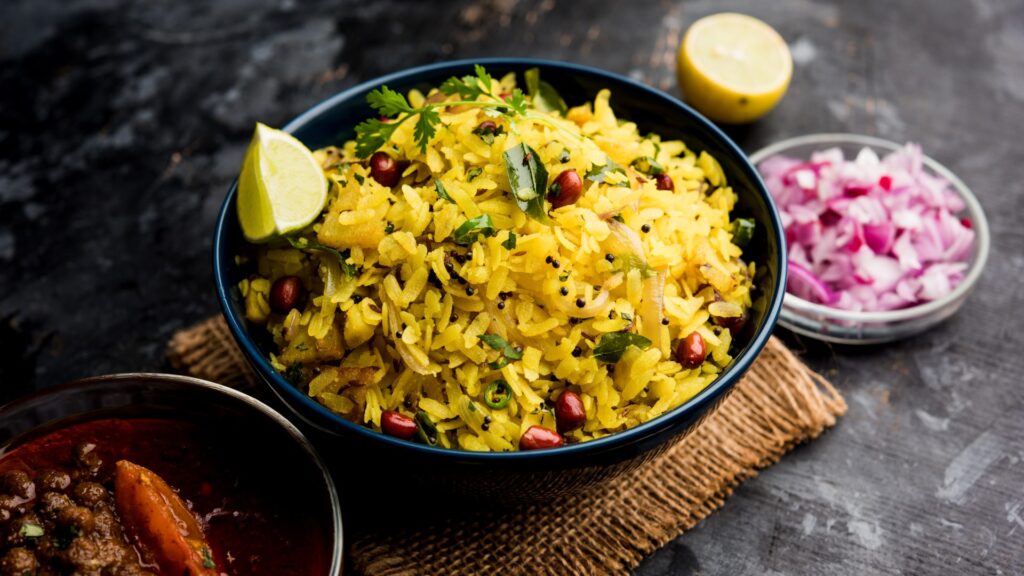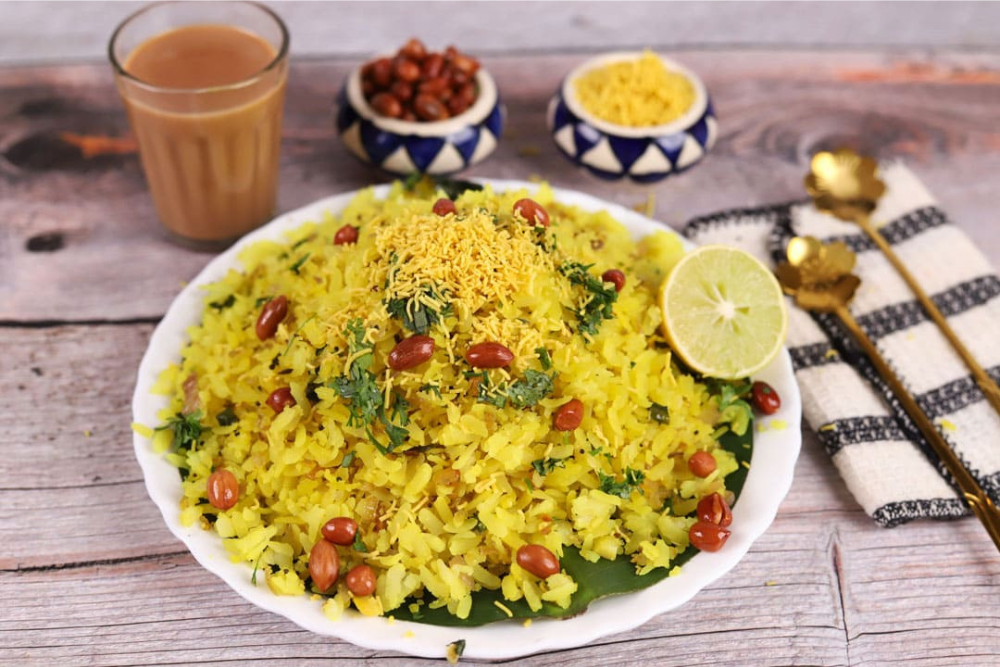Step-by-Step Recipe for Hing Poha with Coconut & Curry Leaves
- Rinse 1 cup of thick poha in water and let it sit for 5 minutes to soften. Drain excess water.
- Heat 1 tablespoon of oil in a pan on medium flame.
- Add 1 teaspoon mustard seeds and let them splutter.
- Add 1/4 teaspoon hing (asafoetida), a few curry leaves, and 1 chopped green chilli. Sauté for 30 seconds.
- Optional: Add 1 tablespoon chopped onions or boiled peas for extra flavour.
- Add the soaked poha along with salt to taste and mix gently.
- Sprinkle 2 tablespoons of freshly grated coconut and stir to combine.
- Cook for 2–3 minutes on low flame until poha is heated through.
- Turn off the heat and squeeze fresh lemon juice over the poha.
- Garnish with coriander leaves and optional roasted peanuts or MevaBite dry fruits for added texture.
Hing Poha is a delicious and easy-to-make Indian breakfast recipe that blends the digestive benefits of asafoetida (hing) with the tropical flavour of coconut and the aromatic touch of curry leaves. Here’s everything you need to know about this flavorful combination.
What are the health benefits of adding hing to poha?
Short Answer: Hing in poha supports digestion, reduces bloating, and enhances gut health, making it ideal for a light and healthy breakfast.
Long Answer:
- Improves Digestion: Hing acts as a natural laxative and relieves issues like constipation and indigestion.
- Reduces Bloating: It prevents gas formation and helps maintain a calm stomach after meals.
- Anti-inflammatory Properties: Asafoetida has anti-inflammatory compounds that aid in relieving abdominal pain.
- Antibacterial Benefits: Regular intake of hing may reduce bacterial infections in the gut.
- Boosts Metabolism: Hing stimulates digestive enzymes, accelerating nutrient absorption.
How does coconut enhance the flavor and nutrition of hing poha?
Short Answer: Coconut adds a creamy texture, enhances flavor, and provides essential nutrients like healthy fats, fiber, and minerals to hing poha.
Long Answer:
- Improves Texture: Grated coconut adds a rich, moist, and slightly sweet taste that balances the pungency of hing.
- Provides Healthy Fats: It contains medium-chain triglycerides (MCTs) that offer quick energy and boost brain function.
- Rich in Fibre: Coconut improves digestion and adds to the satiety value of the poha.
- Mineral-Rich: It contains manganese, copper, and selenium, beneficial for bones and immunity.
- Natural Sweetness: Adds a mild sweetness to balance spices like mustard seeds and curry leaves.
Can I make hing poha without curry leaves, or is it essential for the recipe?
Short Answer: Yes, you can make hing poha without curry leaves, but including them enhances aroma, flavour, and health benefits significantly.
Long Answer:
- Aroma Enhancer: Curry leaves offer a unique fragrance that completes the traditional South Indian flavour of the dish.
- Rich in Antioxidants: They protect cells from oxidative stress and damage.
- Supports Hair and Skin Health: Curry leaves are known for improving hair texture and skin clarity.
- Improves Blood Sugar Control: They help manage blood glucose levels when consumed regularly.
- Optional Substitute: If not available, substitute with coriander leaves for freshness, but the traditional taste might vary.
Is hing poha suitable for people with digestive issues or acidity?
Short Answer: Yes, hing poha is gentle on the stomach and helps soothe digestive issues and acidity due to the properties of hing and light poha base.
Long Answer:
- Soothing Base: Flattened rice (poha) is light and easy to digest, making it suitable for sensitive stomachs.
- Hing for Acidity Relief: It neutralizes gas and reduces the feeling of acidity or heartburn.
- Coconut’s Alkaline Nature: It reduces stomach inflammation and balances pH levels.
- Low in Oil: Hing poha is usually prepared with minimal oil, making it less irritating to the stomach lining.
- Balanced Nutrition: The dish offers carbs, fats, and some protein, preventing acid reflux triggers from empty stomachs.
What are some quick variations of hing poha for busy mornings?
Short Answer: Quick hing poha variations include adding sprouts, nuts, or veggies like carrots and peas, making it nutritious and faster to prepare.
Long Answer:
- Sprouted Moong Poha: Add sprouted green gram to increase protein and fiber content.
- Dry Fruit Hing Poha: Mix almonds, raisins, or cashews from MevaBite for crunch and nutrition.
- Veggie Boost: Include chopped carrots, beans, and peas for a colourful, nutrient-packed version.
- Onion-Free Poha: For those avoiding onion or garlic, use more coconut and ginger for flavour.
- Lemon-Hing Poha: Add lemon juice after cooking for a tangy and refreshing twist.
Hing Poha Nutritional Table
| Nutrient | Approximate Value (per serving) |
|---|---|
| Calories | 210 kcal |
| Protein | 4.2 g |
| Fat | 7.8 g |
| Carbohydrates | 32 g |
| Fibre | 2.5 g |
| Sodium | 140 mg |
Conclusion
Hing Poha with Coconut & Curry Leaves is not just a regional delight but a powerful combination of taste and health. The digestive properties of hing, the nourishing fats of coconut, and the antioxidant-rich curry leaves make it an ideal breakfast or snack. Whether you’re looking for a gut-friendly recipe or a flavour-packed start to your day, this simple poha variant ticks all the boxes. Try different variations using Hingwala’s premium nuts and dry fruits to elevate your hing poha experience!





